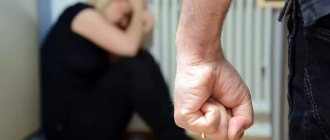Situations often arise when a person is forced to take any action and experiences bullying and torture .
For example, relationships with mentally ill people, criminal elements, and so on contribute to the emergence of danger to human life and health.
How to avoid such influence and what can be done to ensure that it bypasses you? This is what our article is about.
As practice shows, such a crime as torture occurs more and more often every year . This is primarily due to the fact that people thus try to take out their anger on another person, causing him pain and other unpleasant consequences.
What is the article in the Criminal Code of the Russian Federation?
Torture is understood as causing mental , as well as physical and moral .
In addition, torture is characterized by systematic beatings, which are accompanied by various types of torture, threats, some kind of violent manifestations, tying up the victim, and insults.
In addition, the victim is deprived of all kinds of sleep and food.
All this causes moral and mental harm to human health, and the physical impact also affects the health of the victim. Article 117 of the Criminal Code of the Russian Federation is devoted to torture .
What is the torture of Art. 117 of the Criminal Code of the Russian Federation differs from beatings, Art. 116 of the Criminal Code of the Russian Federation?
Torture and beatings are two similar crimes, which even in the Code are given adjacent places. However, these acts are not identical, but have a number of significant differences.
Battery is a less serious crime than torture. The main differences between these two crimes are as follows:
- The beatings are episodic, and the torture is systematic;
- Beatings cause only physical harm to the health of the victim, which is subsequently assessed by a medical expert, while torture causes both physical and moral harm;
- The maximum penalty for beating is 2 years in prison, and for torture a person can go to jail for 7 years;
- The motive for beatings most often lies in hooligan motives, and torture is committed with the aim of deliberately humiliating a person or to satisfy selfish motives;
- During beatings, standard instruments of crime are used - knives, sticks, and during torture, sophisticated ones are used in the form of electric shockers, torture devices, and asphyxiants.
In general, beatings are most often decriminalized and qualified under Art. 6.1.1 Code of Administrative Offenses of the Russian Federation . As a rule, it occurs during family quarrels and domestic conflicts. Much less often, beatings lead to significant harm to a person’s health.
Objective and subjective side
The object of this crime should be understood as life, as well as human health, both physical and moral. The objective side of this crime is quite broad and therefore subject to detailed consideration.
So, in general, the objective side is characterized as the systematic infliction of beatings or the commission of other actions involving violence against a person. The purpose of committing such actions is to bring all kinds of suffering .
Let us divide all the actions committed during torture into two groups. In one there will be mainly actions aimed at beatings . In the other - different.
Let's start with the beatings. Battering in itself is a blow in its plural form. Infliction of beatings is the repeated striking of the victim, or rather, multiple blows , which occur in one single and very short period of time.
If we talk about other actions associated with violence , then they should be understood as:
- pinching – leaving marks on the victim’s body in the form of strong compression of the skin;
- biting – leaving bite marks of varying degrees of strength on the victim’s body;
- section – leaving on the victim’s body traces from rods and other objects intended in this particular case to cause damage to the skin, and therefore section of the skin;
- thermal effects - the use of electrical appliances as torture;
- pricking – impact on the victim’s skin with the aim of leaving puncture wounds;
- deprivation of food and water - actions aimed at depriving the victim of strength and ability to resist the offender.
Subjective side of Art. 117 of the Criminal Code of the Russian Federation , is characterized by direct intent . Thus, we can say that the person knew about the onset of socially dangerous consequences, desired their occurrence and did everything for their occurrence .
The subject of this crime is a person who has reached the age of sixteen, capable and sane.
What is torture?
Art. 117 of the Criminal Code of the Russian Federation in the first part defines the concept of torture.
Torture is the systematic infliction of beatings or other violent actions with the aim of causing physical or mental suffering, if these actions did not lead to consequences in the form of causing serious or moderate harm to health.
Simply put, it is bullying, an act of cruelty towards another person that occurs more than once.
If, nevertheless, as a result of torture, moderate or severe harm to the victim’s health was caused, these actions will be qualified under Art. 111 or art. 112 of the Criminal Code of the Russian Federation.
Actions that fall under the concept of torture must involve repeated or prolonged infliction of pain.
Everyone understands what beatings are, but what the legislator put into the concept of “other violent actions” needs to be deciphered.
So, other violent actions include:
- Section;
- Pinching;
- Biting;
- Blocked breathing;
- Causing small but multiple injuries with sharp or blunt objects;
- Impact of temperature factors;
- Application of electric current;
- Actions of an offensive nature;
- Torture of genital organs;
- Deprivation of food or water, etc.
In a word, torture is various types of torture that actually do not cause tangible harm to a person’s health, but cause him physical or moral suffering.
What is the goal of the torturers?
The goals of the torturers are varied, but they always take place. Without a purpose, simply committing torture will not be qualified under the article “Torture.”
In Art. 117 of the Criminal Code of the Russian Federation, the legislator indicated that torture is committed in order to induce actions contrary to the will of a person.
In case of several episodes of beating of one victim with a significant gap in time, his actions will not be considered systematic torture.
The purpose of torture may be:
- Obtaining certain information (trade secrets, password from a safe deposit box, etc.);
- Extorting a confession of something (stealing money, treason, etc.);
- Compulsion to perform certain actions (signing documents, issuing a passport, etc.);
- Perverted fantasy or sexual dissatisfaction (in the case of genital torture);
- Mental disorders of the criminal.
Often it is mental disorders that become the basis for such behavior. A sick person is not aware of why he should commit torture, but cannot resist the disease.
Criminal legal characteristics
Torture is caused by various factors. They were carefully studied not only by law enforcement officials, but also by scientists and psychologists. Based on the data obtained, the experts came to the following conclusions that the torture was of the following nature:
- Revenge may be the cause of torture. Bullying, for example, an employee at work leads to the person taking out his anger on other people;
- the cause of torture may be a perverted fantasy;
- sexual dissatisfaction;
- mental disorders and deviations, etc.
In any case, such behavior is considered abnormal and requires various types of checks.
In Russia, noisy neighbors have begun to be prosecuted
Today I want to talk about one unique case in the history of Russian justice - for the first time a person was brought to criminal responsibility for not giving his neighbors peace of mind.
Where it all started
The story began 2 years ago in the city of Novgorod, when a man’s neighbors had a child. The child disturbed the man by allegedly stomping loudly.
After that, he became angry with all the neighbors and their children. The man bought himself equipment for loud sound playback and began playing music loudly day and night, and then sounds.
At first he played classics and rock, but then he started using a recording of a horse neighing, while plugging his ears with earplugs. So for 2 years the man interfered with the quiet life of an entire entrance.
When residents of the house came to talk to him, he reacted aggressively and threatened to go to the police if his health was harmed. Wherever the neighbors wrote complaints and statements and under whatever articles, they all shrugged their shoulders.
The police came, talked to him, drew up a protocol for violating the silence, he received fines, but the man just grinned and threatened that he would harass everyone. The residents even turned to a psychiatric clinic for help, but there was nothing they could do to help.
Contacting the media
And a few months ago, neighbors contacted the local media with their problem. Journalists arrived, filmed a report, and the situation acquired the status of a public outcry.
The police had to intervene, and a few days later an investigative team came to the man along with a capture team.
The investigation opened a criminal case against the restless neighbor under Art. 117 of the Criminal Code of the Russian Federation (“Torture”), which carries a penalty of up to 3 years in prison.
On the same day, the court arrested this citizen and placed him in a temporary detention facility pending trial. The neighbors of this citizen were very happy and grateful that now they can rest peacefully in silence without neighing horses.
- It is not yet clear what decision the court will make, but the fact that he will receive some kind of punishment is one hundred percent.
- If such cases are repeated, then law enforcement agencies will develop a positive practice in this kind of cases and it will be easier to deal with particularly noisy neighbors.
- So if you have similar neighbors who do not allow you to rest peacefully by loudly playing horses neighing or music, you can call the police and show the practice of their Novgorod colleagues.
Kinds
The same article of the Criminal Code establishes the types of torture. For example, torture can be carried out against two or more persons . In this case, such a crime will be considered qualified .
In relation to a woman who the offender knew was pregnant . That is, if the offender knew about the pregnancy or saw the belly, the crime is considered qualified . If a woman kept silent about her situation and her sentence was short and the criminal did not guess, the composition will not be considered qualified .
If the crime was committed against a minor, the composition will also be considered qualified.
Another type of torture is the use of torture . Torture is the systematic infliction of pain in order to get what you want.
Carrying out torture not alone, but by an organized group of people is also a qualifying feature of the crime.
Carrying out torture for hire requires the presence of not only a performer , but also a customer , who must bear responsibility equally with everyone else.
Another important feature is the motive of racial, religious and national enmity .
This is unacceptable on the territory of our state, and therefore must be stopped immediately.
Qualification of the composition according to Part 2 of Art. 117 Criminal Code
Circumstances for qualifying the object of criminal episodes of Part 2 of Art. 117 of the Criminal Code of the Russian Federation, when analyzed, is similar to the composition of Articles 111 and 112 of the Code.
Tightens liability for illegal actions expressed in torture, their commission in the following situations:
- Several people were bullied.
- Suffering was inflicted on persons performing labor or public duties.
- The defendant knew his victim was pregnant.
- Torture was used against children, people dependent on the perpetrator of harm, or abducted by him.
- The physical and mental impact was aggravated by torture.
- The torture was carried out by an organized company of criminals.
- The bullying was committed on the basis of national, political or religious hatred.
The presence of aggravating factors leads to only one type of punishment: isolation of the offender from society for a maximum of 7 (seven) years.
The victim’s dependence on the torturer can be expressed in the following forms:
- material;
- official;
- guardianship;
- related.
An addiction of any type must be significant to the victim. A dependent position reduces or completely deprives a person of the ability to resist the actions of a criminal.
Torture of a minor presupposes that the offender knows the approximate age of his victim. If the appearance of the victim does not allow one to determine his true age, then the charge under paragraph “d” of Part 2 of Article 117 of the Criminal Code of the Russian Federation is excluded from aggravating circumstances. In this case, the judicial authorities are guided by the explanations of the Resolution of the Plenum of the Supreme Court of the Russian Federation dated December 4, 2014 No. 16.
Qualification
Torture can be classified as a serious crime and there are reasons for this. Firstly, torture can be qualified as causing grievous bodily harm to a citizen. Agree, that’s why the sanctions for such a crime are justifiably high .
Also, torture not only causes grievous harm, but can also result in death through negligence . Torture is also qualified as a crime directed against the moral and mental health of a citizen.
Taken together, all these factors indicate that the inevitability of sanctions for such crimes is guaranteed.
Corpus delicti
The object of torture is the individual and his rights to free relationships with society. As a result of violent actions, a person receives moral and physical injuries, which can lead to disruption of his communication with other people. The victim begins to fear and feel inferior.
The objective side of torture is expressed by the actions of the perpetrator and the evidence base for the commission of the crime.
Among the evidence:
- Time and place of the crime. It is important to record all cases of violence by the perpetrator.
- Duration and frequency of strikes, if there are more than two in a row.
- The intensity of the attacker's force and the pain experienced by the victim.
Torture is not only the infliction of physical pain, but also the deprivation of water and food or keeping a person in conditions that cause him suffering.
The subject of torture can be any capable person over the age of 16 who is aware that he is committing illegal actions and causing pain to another person.
The subjective side of this crime is the motive for its commission. A common motive is outdated ideas about the rules of upbringing in families with a low level of cultural development. An equally common motive is jealousy of cohabitants and wives.
Hooligan motives and the desire to become a leader among youth are a common motive for teenage violence.
An aggravating circumstance is the commission of torture while under the influence of alcohol or drugs. Mitigating - actions of the victim that provoke an attack on her.
Criminal liability
Since torture is by its nature a serious crime, the sanctions imposed are not the most favorable . Thus, for the acts provided for in part one, it is necessary to impose a punishment in the form of restriction of freedom for a term of up to three years, in general.
It is also possible to impose forced labor for up to three years or imprisonment for the same period.
If the crime has qualifying characteristics , then the punishment will be appropriate.
Thus, the term of imprisonment will vary from three to seven years .
Read also
The pain of parallel parking
The Torment of Parallel Parking Looking at the many cars parked parallel to the sidewalk on the street, can you tell where the car was parked by a woman and where by a man? Research commissioned by the English Driving School showed that parking a car
SHOULD YOU TOLERATE HUSBAND BEATINGS?
SHOULD YOU TOLERATE HUSBAND BEATINGS? I am 26 years old, I have the following problem in my relationship with my husband: he is easily excitable, can “boil” for no reason, and often comes to the point of assault on his part. This became especially frequent and made him more aggressive after a recent history of
“By wagging its tail, a dog gets its food, but by barking, it only gets beaten.”
“By wagging its tail, a dog gets its food, but by barking, it only gets beaten.” Elbert Hubbard. At one time, this name was known to almost every American. This journalist gained his fame with his unusually bilious polemical articles, which caused streams of harsh
Puzakovsky tortures in Moscow
Puzakov's torment in Moscow Well, I left for Vladimir in Moscow. There is no money in my pocket. The attempt to create a community of honest entrepreneurs failed. Even despite the financing by Artem Tarasov, who offered Puzakov several tens of thousands of dollars.
The torment of maximizing choice
The Pain of the Maximizing Choice If you are a maximizer, you will spend many hours evaluating and comparing all your options, trying to make the right choice to get the maximum benefit. For example, when choosing shoes, you try on all the models you like in a certain
Myth five Treatment methods in psychiatry are designed specifically to cause suffering in patients and break their will.
Myth fifth Treatment methods in psychiatry are designed specifically to cause suffering in patients and break their will. I greatly respected the late Alexander Nikolaevich Yakovlev, the “architect” of Perestroika, for his courage to renounce communist dogmas and
Difference from beatings
It would seem that two such identical concepts, however, they are not always and not in everything as similar as it seems. For example, beating is expressed in striking and thereby causing physical pain to a person.
Torture is a set of beatings inflicted over a certain period of time with a certain frequency.
Beatings , as a rule, are characterized by the infliction of physical violence , and torture is also characterized by the infliction of mental violence . Beatings are not accompanied by bites, injections, and so on, but torture is complete. This is where all the main differences between torture and beatings end.
Beatings, torment, torture
Small, infrequent injuries (abrasions, bruises, small superficial wounds) that do not entail short-term health problems or minor permanent loss of general ability to work are not regarded as harm to health.
Battery does not constitute a special type of injury. They are actions characterized by repeated strikes (three times or more).
Battery includes actions that cause physical pain that does not reach consequences that can be assessed as severe, moderate or minor harm to health. As a result of beatings, physical injuries may occur. However, beatings may not leave behind any objectively detectable injuries.
Damage to health, even if minor, is caused by any injury, but not every injury entails a health disorder.
If, as a result of repeated blows, harm to health occurs (severe, moderate or light), then such actions are not considered as beatings, but are assessed as causing harm to health of the corresponding severity.
If, after striking the victim, injuries are discovered (abrasions, bruises, small wounds that do not entail temporary loss of ability to work or a slight permanent loss of general ability to work), they are described, noting the nature of the damage, localization, signs indicating the properties of the object that caused them, age and the mechanism of formation. At the same time, these injuries are not regarded as harm to health and their severity is not determined.
If the beatings do not leave behind objective traces, then the forensic expert in the “Conclusion” notes the complaints of the witness, including pain on palpation of certain areas of the body, the absence of objective signs of damage and does not determine the severity of the harm to health. In such cases, the establishment of the fact of beatings is carried out by the bodies of inquiry, preliminary investigation, prosecutor's office or court on the basis of non-medical data.
Torment and torment are actions that may result in harm to health.
Source







